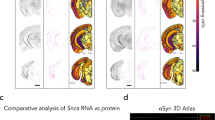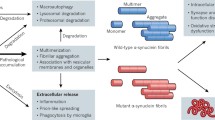Abstract
Mutations in the DJ-1 gene have been identified to cause Parkinson's disease. In humans, nonmutated DJ-1 is expressed in specific brain areas but seems to be expressed by astrocytes rather than by neurons. In contrast, DJ-1 mRNA is mainly found in neurons in the mouse brain. We have investigated the distribution of DJ-1 protein in the mouse brain and found that DJ-1 protein is predominantly expressed by neurons but can also be detected in astrocytes. Consistent with a global role of DJ-1 in the brain, we found immunoreactivity, for example, in cortical areas, hippocampus, basolateral amygdala, the reticular nucleus of the thalamus, zona incerta, and locus coeruleus. Within the substantia nigra, however, DJ-1 is localized in both neuronal and nonneuronal cells, suggesting a distinct role in this area.


Similar content being viewed by others
Abbreviations
- BLA:
-
basolateral nucleus of the amygdala
- CA1, CA2, CA3:
-
hippocampal fields CA1–CA3
- CPU:
-
caudate-putamen
- DG:
-
dentate gyrus
- LA:
-
lateral nucleus of the amygdala
- LC:
-
locus coeruleus
- LS:
-
lateral septum
- M:
-
motor cortex
- PIR:
-
piriform cortex
- PIR:
-
homeostatic model assessment
- RT:
-
reticular nucleus of the thalamus
- SNpc:
-
substantia nigra pars compacta
- SOM:
-
somatosensory cortex
- ZI:
-
zona incerta
References
Abou-Sleiman PM, Healy DG, Wood NW (2004) Causes of Parkinson's disease: genetics of DJ-1. Cell Tissue Res 318:185–188
Bandopadhyay R, Kingsbury AE, Cookson MR, Reid AR, Evans IM, Hope AD, Pittman AM, Lashley T, Canet-Aviles R, Miller DW, McLendon C, Strand C, Leonard AJ, Abou-Sleiman PM, Healy DG, Ariga H, Wood NW, de Silva R, Revesz T, Hardy JA, Lees AJ (2004) The expression of DJ-1 (PARK7) in normal human CNS and idiopathic Parkinson's disease. Brain 127:420–430
Bonifati V, Rizzu P, van Baren MJ, Schaap O, Breedveld GJ, Krieger E, Dekker MC, Squitieri F, Ibanez P, Joosse M, van Dongen JW, Vanacore N, van Swieten JC, Brice A, Meco G, Van Duijn CM, Oostra BA, Heutink P (2003) Mutations in the DJ-1 gene associated with autosomal recessive early-onset Parkinsonism. Science 299:256–259
Braak H, Del Tredici K, Bratzke H, Hamm-Clement J, Sandmann-Keil D, Rub U (2002) Staging of the intracerebral inclusion body pathology associated with idiopathic Parkinson's disease (preclinical and clinical stages). J Neurol 249(Suppl 3):1–5
Forno LS (1996) Neuropathology of Parkinson's disease. J Neuropathol Exp Neurol 55:259–272
Nagakubo D, Taira T, Kitaura H, Ikeda M, Tamai K, Iguchi-Ariga SM, Ariga H (1997) DJ-1, a novel oncogene which transforms mouse NIH3T3 cells in cooperation with ras. Biochem Biophys Res Commun 231:509–513
Neumann M, Muller V, Gorner K, Kretzschmar HA, Haass C, Kahle PJ (2004) Pathological properties of the Parkinson's disease-associated protein DJ-1 in alpha-synucleinopathies and tauopathies: relevance for multiple system atrophy and Pick's disease. Acta Neuropathol (Berl) 107:489–496
Rizzu P, Hinkle DA, Zhukareva V, Bonifati V, Severijnen LA, Martinez D, Ravid R, Kamphorst W, Eberwine JH, Lee VM, Trojanowski JQ, Heutink P (2004) DJ-1 colocalizes with tau inclusions: a link between Parkinsonism and dementia. Ann Neurol 55:113–118
Shang H, Lang D, Jean-Marc B, Kaelin-Lang A (2004) Localization of DJ-1 mRNA in the mouse brain. Neurosci Lett 367:273–277
Shendelman S, Jonason A, Martinat C, Leete T, Abeliovich A (2004) DJ-1 is a redox-dependent molecular chaperone that inhibits alpha-synuclein aggregate formation. PLoS Biol 2:e362
Taira T, Saito Y, Niki T, Iguchi-Ariga SM, Takahashi K, Ariga H (2004) DJ-1 has a role in antioxidative stress to prevent cell death. EMBO Rep 5:213–218
von Bohlen und Halbach O, Unsicker K (2002) Morphological alterations in the amygdala and hippocampus of mice during aging. Eur J Neurosci 16:2434–2440
von Bohlen und Halbach O, Schober A, Krieglstein K (2004) Genes, proteins, and neurotoxins involved in Parkinson's disease. Prog Neurobiol 73:151–177
Xu J, Zhong N, Wang H, Elias JE, Kim CY, Woldman I, Pifl C, Gygi SP, Geula C, Yankner BA (2005) The Parkinson's disease-associated DJ-1 protein is a transcriptional co-activator that protects against neuronal apoptosis. Hum Mol Genet 14:1231–1241
Yokota T, Sugawara K, Ito K, Takahashi R, Ariga H, Mizusawa H (2003) Down regulation of DJ-1 enhances cell death by oxidative stress, ER stress, and proteasome inhibition. Biochem Biophys Res Commun 312:1342–1348
Acknowledgements
N.K. was supported by a fellowship from the Deutscher Akademischer Austauschdienst (German Academic Exchange Service). We wish to thank the Deutsche Forschungsgemeinschaft (SFB 636/A5) for financial support.
Author information
Authors and Affiliations
Corresponding author
Rights and permissions
About this article
Cite this article
Kotaria, N., Hinz, U., Zechel, S. et al. Localization of DJ-1 protein in the murine brain. Cell Tissue Res 322, 503–507 (2005). https://doi.org/10.1007/s00441-005-0023-1
Received:
Accepted:
Published:
Issue Date:
DOI: https://doi.org/10.1007/s00441-005-0023-1




